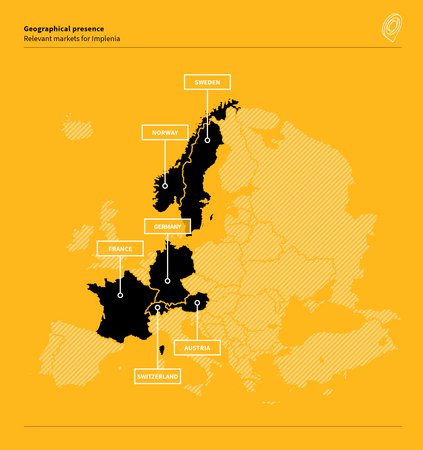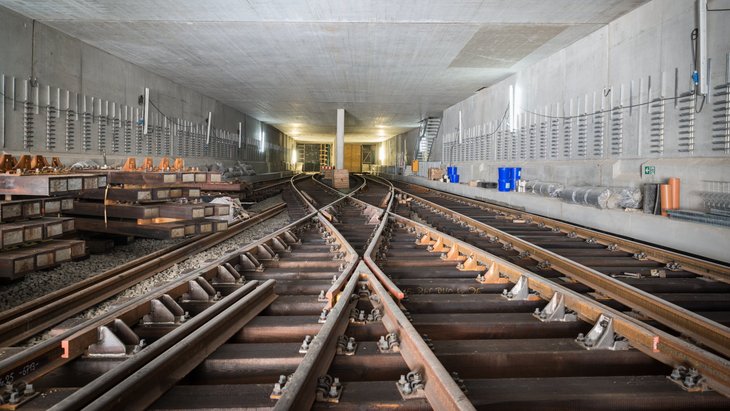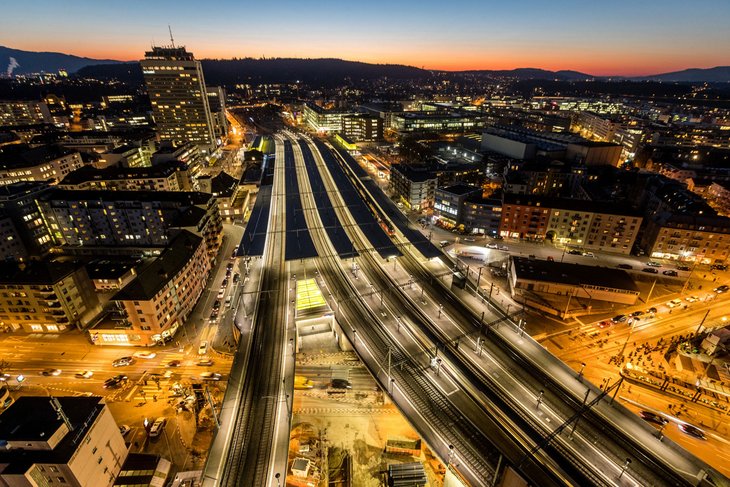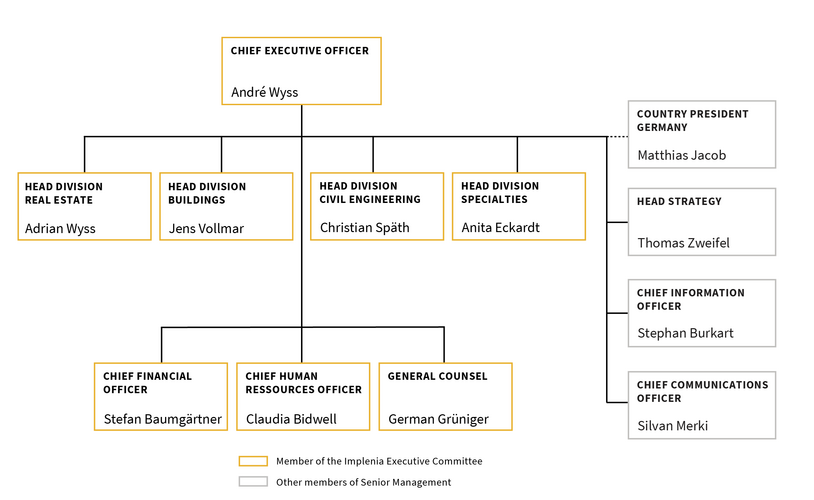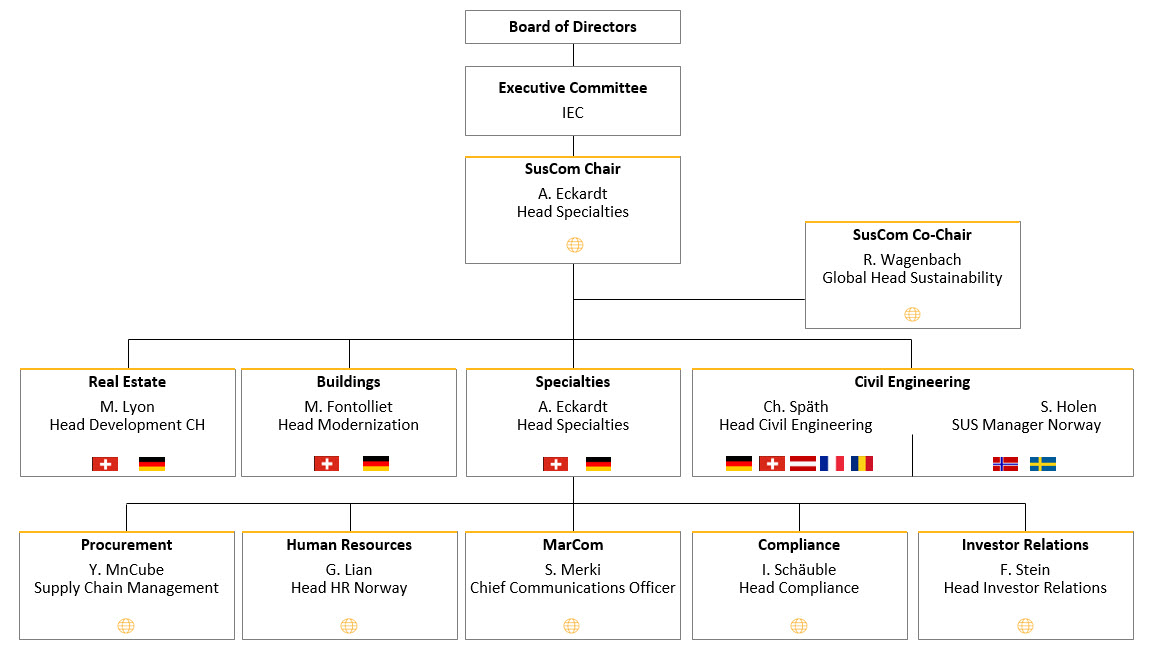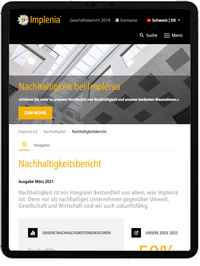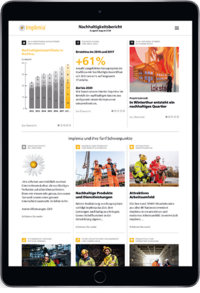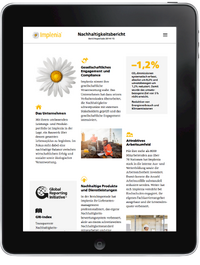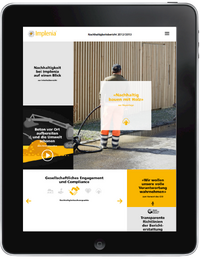


Sustainability at Implenia
Implenia is Switzerland’s leading construction and construction services company. It also has strong positions in the German, French, Austrian, Swedish and Norwegian infrastructure markets, as well as significant building construction and civil engineering operations in German-speaking Europe. In everything it does, Implenia focuses not just on economic objectives, but also on its responsibilities to society and the environment.
Content
Editorial
GRI 102-14
Talking to customers, I sense an increasing interest in our sustainable products and services. More and more market participants recognise the need to do business sustainably, but they also see the opportunities this presents. This applies in particular to the public sector, which attaches increasing weight to sustainability and innovation criteria when awarding contracts.
Demand for sustainable building construction and infrastructure projects is rising accordingly. Thanks to our expertise and our many years of experience in sustainable construction, we are well able to meet this demand. I am proud to lead a company that was quick to recognise the sign of the times and that has built up a formidable bank of knowledge and skill. Sustainability is one of Implenia’s five corporate values and a fixed component of our corporate strategy.
The coronavirus pandemic has shown that companies need to build on solid long-term business practices. They can only do this if they set scientifically sound environmental goals, engage with the world beyond their immediate business interests, respond to social needs, and so evolve together with the environment in which they operate.
We have made good progress in this regard, but are still a long way from the end of the journey. This brings us to the twelve new sustainability goals that we have set for 2025.
Thinking and acting sustainably can, and should, be an even bigger part of our everyday life. We will continue along our chosen path – as a group, as a team and as individual employees. It takes courage to go further. It takes courage to break out of old patterns and search for even better solutions.
I place great hope in the developments we are seeing in digitalization and the circular economy. Implenia wants to make a difference in these areas and set standards for our industry. We have the specialists we need to lead by example. And we have new contractual models that encourage a partnership approach.
I invite everyone, inside and outside our company, to work with us even harder on sustainable concepts, processes and products and to find common solutions for the future.
Thank you for your support. I look forward to seeing what we can achieve together.
André Wyss, CEO
Implenia at a glance
GRI 102-1, 102-2, 102-3, 102-4, 102-5, 102-6
Implenia is an international construction and real estate services company with its head office in 8152 Glattpark (Opfikon), near Zurich. It can look back on around 150 years of tradition in the construction sector. The company’s experience, size and financial strength allow it to prioritise sustainability in its home markets of Switzerland, Germany, Austria, Norway, Sweden and France. With its broad offering and the deep experience of its specialists, the Group can realise complex major projects and provide integrated, customer-centric support across the entire life-cycle of a building or structure. Implenia employs more than 7,000 people across Europe and achieved revenue of around CHF 4 billion in 2021. The company is listed on the SIX Swiss Exchange (IMPN, CH0023868554). All the financials can be found in the company’s Annual Report.
Main services
GRI 102-16
GRI 102-10, 102-45, 102-48
Implenia is organised into four divisions, several global functions and a competence centre. Divisions Real Estate, Buildings, Civil Engineering and Specialties operate successfully in their markets by taking commercial responsibility and applying their combined expertise. The global functions (Finance, HR, Legal, Marketing/Communications and IT) support the divisions and provide Group-wide leadership on their areas of expertise. To ensure Implenia remains close to its customers and maintains deep local roots, it has established regional and national organisations to represent its interests across all divisions.
GRI 102-18, 102-22, 102-23
The Group’s most senior management bodies are the Board of Directors (Board), which appoints and monitors the operational executives, and the Implenia Executive Committee (IEC), which is made up of the CEO, the CFO, the CHRO, the General Counsel, the Head Country Management and the Heads of the four Divisions. The Board of Directors has seven members and is responsible for the Group’s strategic and financial leadership. None of the members of the Board of Directors performs an operational management role for Implenia or any of its Group companies.
Sustainability organisation
Implenia has set up an internal structure dedicated to embedding sustainable development within the company: The Sustainability Department in Division Specialties. This global department helps all divisions and global functions achieve their sustainability goals. In collaboration with local specialists from the other divisions and country units, our sustainability experts take care of sustainability management and reporting, support measures within construction projects and promote initiatives at Group level. The Sustainability Department provides both project-specific services (Sustainable Construction and Environmental Protection) and internal services (Sustainable Implenia). Anita Eckardt, Head of Division Specialties, represents sustainability issues as the responsible person on the Implenia Executive Committee.
GRI 102-18, 102-20, 102-26, 102-32
The Sustainability Department is supported and overseen by the Sustainability Committee (SusCom), which is made up of representatives from all the divisions and the global functions. The committee is chaired by Anita Eckardt, Head Division Specialties. She also brings SusCom’s decisions to the Implenia Executive Committee. SusCom meets four times a year to discuss the latest issues, define sustainability goals, take strategic decisions and launch Group-wide initiatives relating to matters such as the Group’s social commitments, ethical guidelines, working conditions and environmental protection measures. Sustainability reporting is also reviewed by the Sustainability Committee.
Sustainability management
GRI 103-2, 103-3
Sustainable development is a holistic concept, which has to be put into practice across all areas. It is a Group-wide responsibility that touches on all activities and that requires the commitment of all employees at every level of the company. This is why Implenia follows an integrated form of sustainability management.
The Sustainability Department’s job is to address significant issues in consultation with stakeholders, set Group-wide standards and propose measures and targets for the divisions and global functions. Defined goals and measures are implemented in collaboration with the relevant operational divisions and global functions.
Responsibility for implementation normally rests directly with operational line managers or with the Global Functions, rather than with the Sustainability Department itself. Each division has at least one person responsible for safety, quality and sustainability, including environmental protection. This person plays an important role in bringing sustainability issues into the operational side of the business. Implenia thus ensures that all business units engage intensively with sustainability issues and works to achieve the defined goals.
At the beginning of each year, the divisions and global functions work with the Sustainability Department to define their main annual goals, which are based on the company-wide Sustainability Goals. Over the course of the year, the Executive Committee meets the individuals responsible for the targets at a series of “Touchpoint” sessions. At the first Touchpoint, the annual goals are discussed, amended where necessary and signed off. At subsequent Touchpoints, implementation progress is discussed and next steps are defined. This process allows the responsible people to check regularly whether the measures are doing what they are supposed to do, and to coordinate between individual business units.
Sustainability strategy
Sustainability has been an integral part of our corporate strategy since 2009. The following timeline shows the most important milestones of recent years.
Our milestones
2019
2018
2017
2016
1. Sustainability Report
2011
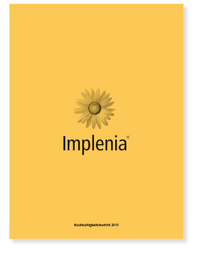
2011
2010
2009

Impact of business activities
GRI 102-15, 103-1
Around 80,000 people work in the Swiss construction sector, generating around CHF 33 billion in added value each year, which is equivalent to around 5% of GDP. In doing so they process a total of 63 million tonnes of material1. 56 million tonnes (88%) of this is accounted for by building materials, and the remaining 7 million (12%) by the energy – measured as oil equivalents – required to process them.
The construction sector’s annual environmental impact comes to a total of 57 trillion environmental impact points2, of which energy consumption is the main driver (56%).
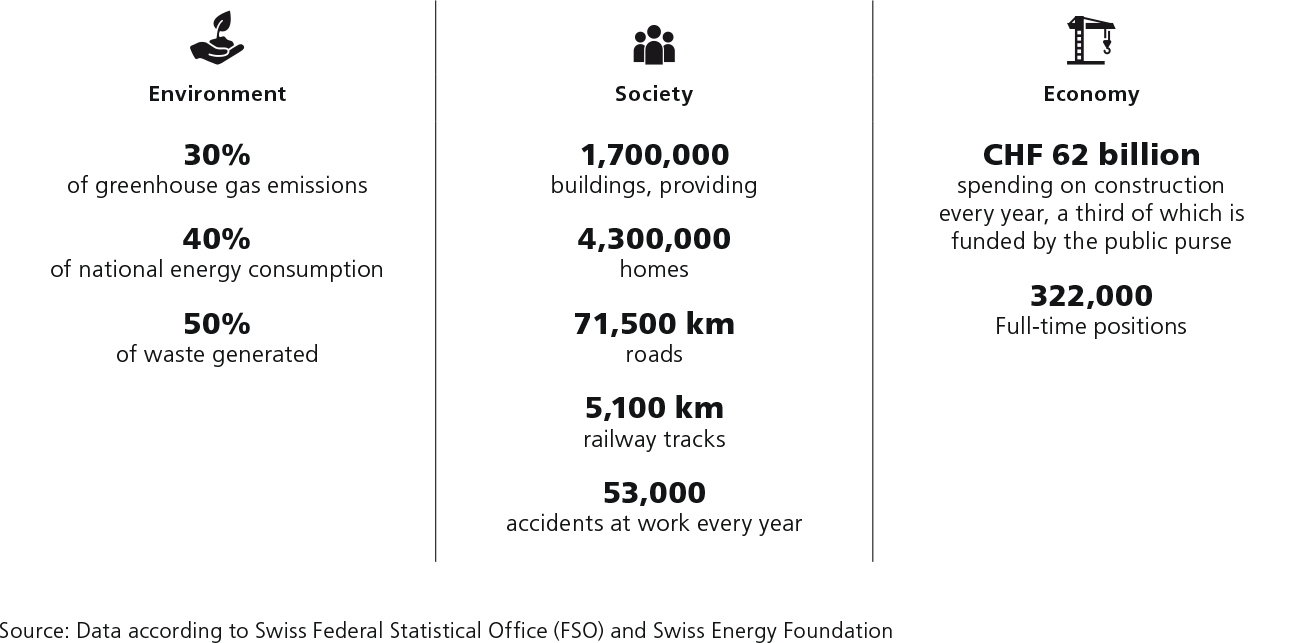
These figures provide a sense of the construction sector’s significance for the economy, society and environment. Implenia’s activities also have significant effects on all three spheres of sustainability. The company takes responsibility for its impact and has made a long-term commitment to the welfare of current and future generations.
Implenia’s opportunities to influence environmental impact varies depending on where its products and services sit within the value chain. At the planning stage of a project, for example, fundamental decisions can still be taken about using “greener” materials and reducing operational energy consumption; but if Implenia only comes in at the construction stage, the main focus will be on environmentally friendly working practices (see also next chapter).
Implenia also uses its leading position in the Swiss construction sector to gain broader acceptance for a sustainable approach – by carrying out pilot projects, for example, by collaborating on standards and by compelling business partners to comply with its Code of Conduct.
Implenia’s highest priority is to help mitigate climate change, so it seeks to reduce its greenhouse gas emissions as much as possible. The Group does this in its own projects by using innovative techniques and materials that use less grey energy, and by minimising direct consumption of fossil fuels at building sites, depots and production facilities.
1 BAFU MatCH Study, 2017
2 Swiss benchmark for calculating life cycle assessments (see explanation under Bundesamt für Umwelt)
Where the company can have an influence
GRI 103-1
With buildings that it develops itself from beginning to end, Implenia can design and plan sustainably right from the start. It can take account of a wide variety of criteria and use the internally developed GeNaB® assessment tool (GeNaB is the German acronym for “total evaluation of sustainable construction”.)
In most cases, however, Implenia works on private and public sector projects as general or total contractor (GC/TC), meaning that it has to follow plans made prior to its involvement. For this type of project, the environmental impact of the building in its operational phase – things like its energy intensity – will already have been largely determined by the client. Implenia can only have an indirect influence in such cases, for example by offering more socially and environmentally friendly options and materials. Ultimately, the decision rests with the client.
However, Implenia still has a significant opportunity to influence the social, environmental and economic impact of a construction project when it plans exactly how it will carry out the work. The company can make most of the decisions about what machinery to use, how to separate and dispose of waste, and what working conditions should apply on site. However, the emissions produced during construction itself are relatively low compared to the total emissions of a building across its entire life cycle.
As a major buyer of construction materials such as concrete, steel, gypsum, natural stone and glass, Implenia is highly dependent on the availability of these resources. This also means that Implenia can make a real difference through its purchasing decisions. It can favour local materials, or only those that have a low grey energy profile. A prerequisite for this, however, is support from the client and a transparent supply chain (see the Supplier management chapter).
Risks and opportunities created by climate change
GRI 102-15
As a construction and real estate services company with a broad portfolio, Implenia is affected by climate change in a variety of ways. As shown in the table below, climate change brings economic opportunities as well as risks. Changes in the climate could, for example, prompt a response from customers that increases the number and size of orders for renovation and modernisation. Measures to mitigate climate change – such as better insulation and renewable energy systems – offer Implenia opportunities to apply its expertise in these areas. At the same time, however, increasingly extreme weather could pose real problems for companies and make it more difficult for them to make plans.
It is almost impossible from the current standpoint to predict what the ultimate effect of climate change will be on businesses. What is certain, however, is that Implenia needs to prepare for the expected change and be ready for future developments.
| Opportunities | Risks |
|---|---|
| Sustainable solutions as a distinguishing feature in private and public tendering processes | Supply problems |
| More stringent requirements for energy efficiency in the building stock require specialist know-how | Volatile raw material prices |
| Greater demand for renewable energy infrastructure (e.g. pumped storage power plants) | Extreme weather events have a negative impact on employees and construction processes |
| Demand for high-quality, robust infrastructure (roads, tunnels, bridges, buildings) that can survive natural disasters | Increasing planning risks |
| Greater demand for building renovation due to extreme weather fluctuations | More complex construction methods owing to more complex requirements (e.g. building technology, building envelopes) |
| Increasingly strict building regulations (e.g. with regard to soil sealing) |
Stakeholder groups
GRI 102-21, 102-40, 102-42, 102-43, 102-44
Implenia’s Code of Conduct defines the company’s most important stakeholders. Our dealings with these stakeholders are briefly described below.
Employees
All of Implenia’s managers are required to foster active dialogue with their staff. One major vehicle for this communication is the target-setting meeting, which takes place every year as part of the management-by-objectives strategy and which is supported by a web-based employee management tool called “iperform”. The company uses various internal communications tools, including the twice-yearly employee magazine “Impact”, the Intranet, staff events (in-person and virtual) and an electronic newsletter. The CEO also communicates directly with employees several times a year in his “CEO Letter” and at townhall meetings.
Implenia actively manages a variety of internal and external social media platforms designed to increase contact between employees. These include the Intranet (internal), LinkedIn (external), Xing (external), Facebook (external), Twitter (external), YouTube (external) and Instagram (external).
Customers
Its customers are at the heart of everything Implenia does. As well as numerous contacts at the project level, the company also seeks general, non-project-specific communication with major customers. Approximately 50 such discussions take place in Switzerland each year. These help foster mutual understanding and give Implenia a valuable external perspective.
Its approach has brought Implenia closer to customers in recent years thanks to improved internal and external interfaces. Meetings take place at management level each month to ensure customers are served as effectively as possible. A survey is conducted after each project finishes to give customers an opportunity to provide detailed feedback on working with Implenia and to rate the company’s services. Implenia also regularly gathers customer statements on topical issues and projects, and then uses internal communications to make these statements available to employees as important feedback.
Shareholders and investors
Implenia follows an open, transparent and timely information policy in the interests of its shareholders, investors and the general public. With its ongoing reporting, Implenia ensures equal treatment of all stakeholder groups with regard to timing and content.
Comprehensive information about the company is available to all investors, journalists and other interested parties under the «Investors» link on our website. Sustainable investors can also find more information in the “Sustainable Investment” section of the site.
Business partners
When choosing business partners, Implenia looks for companies that share its own core values. Subcontractors, suppliers and manufacturers are obliged to follow the Code of Conduct. Implenia has had a supplier management system in place for several years now. This makes business relationships more transparent and enables communication with suppliers and subcontractors on an equal footing. Such relationship are also cultivated at annual “supplier days”.
Public authorities
Implenia is committed to a professional relationship with governmental institutions. The company takes great pains to comply with the laws that apply to its tightly regulated field of activity. In the event of alleged or actual conflicts, the company cooperates fully with the authorities, helps with investigations and communicates transparently.
It also maintains close contact with public sector bodies when engaged in urban development projects. Implenia runs such major projects in close cooperation with the relevant authorities and prefers to hold architectural competitions where possible to ensure the highest standards in terms of sustainability, functionality and aesthetics.
Social partners and associations
As one of the largest employers in the Swiss construction sector, Implenia has a special responsibility to its employees. Consequently, our management maintains a constant, active dialogue with our social partners. Regular meetings are held to share information and discuss each other’s needs. Implenia’s representatives work in various organisations and associations, such as regional builders’ associations and the Network for Sustainable Construction Switzerland (NNBS).
Media
Implenia runs an active and open communication policy. The Communication Department provides the press and electronic media with timely and comprehensive information about important events. Our communication experts also regularly invite journalists to information events (in-person and virtual) to keep them up to date with the company’s activities and business performance. In this way Implenia can provide transparency to the broader public as well as to its specific stakeholder groups.
Society
Media work is only one part of the Group’s information sharing effort. Another important strand is direct contact with the people who are affected by our construction activity. For larger projects, Implenia organises public information events and site visits. Implenia makes particular efforts to communicate actively with local people when it is undertaking projects in urban areas.
Key topics
GRI 102-31, 102-44, 102-47, 102-48, 103-1
Implenia’s sustainability strategy is based on five thematic priorities. The company first formulated these in an internal process in 2010 and has applied them consistently ever since (see chart). These priorities cover the economic, ecological and social dimensions of sustainability and shape the whole Group’s sustainability commitment. They also form the backbone of the company’s sustainability reporting.
Implenia’s sustainability priorities
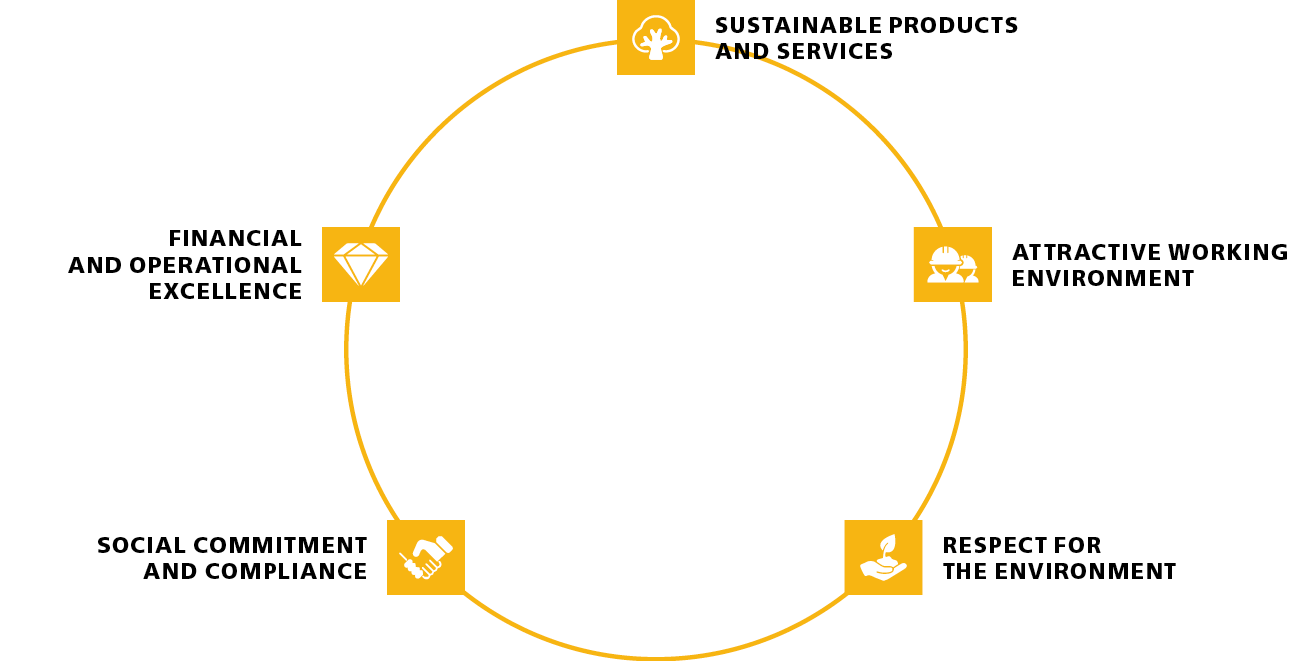
At the end of 2015, Implenia, working with internal and external stakeholders, conducted a materiality analysis based on guidelines set by the Global Reporting Initiative (GRI) in order to review its priorities. The analysis confirmed that the company and its sustainability strategy were on the right track. Two years later the materiality analysis was updated and clarified as part of a workshop attended by 60 managers. The latest review of key sustainability topics was done in 2020 during the formulation of the new 2025 sustainability goals.
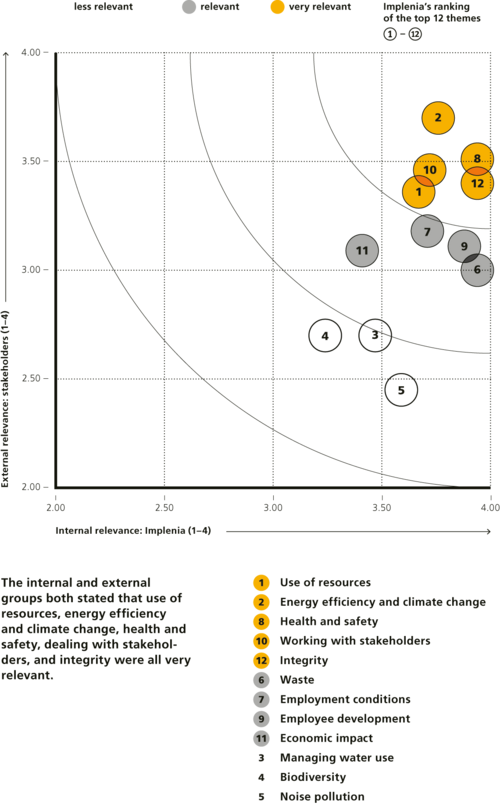
Strategic approaches and key themes of Implenia’s material topics
| Why is the topic relevant and what are the risks and opportunities? | Goals for 2025 |
|---|---|
| Construction projects impact the natural world and cause environmental emissions. The way Implenia builds may also indirectly affect the emissions generated once the completed building is being used (energy consumption for heating and cooling, for example). | To our goals 2025 |
| A large proportion of emissions are generated in the production and procurement of construction materials. It is important, therefore, to raise awareness among suppliers and subcontractors and, where possible, to work with sustainable partners. | |
| Construction is an industry in which there is a high risk of accidents, so ensuring a safe working environment is Implenia’s highest priority. | To our goals 2025 |
| There is a shortage of skilled personnel in the construction industry. Training and developing its own construction workers is therefore crucial to the Group’s long-term effectiveness. | |
| Long-term retention and continuing development of its employees is central to the company’s performance, culture and stability. | |
| The construction industry generates considerable quantities of building waste. It is also one of the largest consumers of energy and, consequently, one of the largest generators of CO2 emissions. | To our goals 2025 |
| Knowledge about the environment is sometimes lacking on construction sites. Environmental protection is not yet consistently embedded in all core processes. | |
| To prevent infringements of the Code of Conduct, employee-awareness measures need to be continued and the principles set out in the Code need to be embedded in business processes. | To our goals 2025 |
| The impact of Implenia’s business activities on the environment, society and the economy is far-reaching. It is important for the company to be involved in the long-term development of its immediate and wider environment. | |
| Knowledge of our own impact is essential if we are to assess and continually develop our mitigation efforts. | |
| As an international company, it is important for us to share experiences and know-how within and between all business units. | To our goals 2025 |
| Clear processes and instructions can help prevent errors and increase efficiency. Owing to the high risks and generally lower margins associated with building projects, efficient and intelligent processes are absolutely critical. |
Sustainable Development Goals
GRI 102-12
Implenia is guided in its sustainability work by the UN’s internationally agreed Sustainable Development Goals (SDGs). The company wants to help achieve these goals. The table shows which SDGs are covered by Implenia and its sustainability priorities.
| Material topics of Implenia | Sustainable Development Goals (SDG) |
|---|---|
Sustainable products and services |
|
| |
|
|
| |
Respect for the environment |
|
| |
| |
Social commitment and compliance |
|
| |
Financial and operational excellence |
|
2025 goals
GRI 102-49, 103-2
In 2020, Implenia set itself a number of long-term sustainability objectives based on the 2015 materiality analysis and the Sustainable Development Goals. The new objectives are for five years rather than for two as previously, i.e. the work done to meet them will take place between 2021 and the end of 2025. For the sake of transparency, the progress of this work and the degree to which objectives have been achieved will be reported in the objectives dashboard section of this report on a continuous basis. The dashboard will also show the sub-goals, as derived from the main objectives, for each division and global function.


